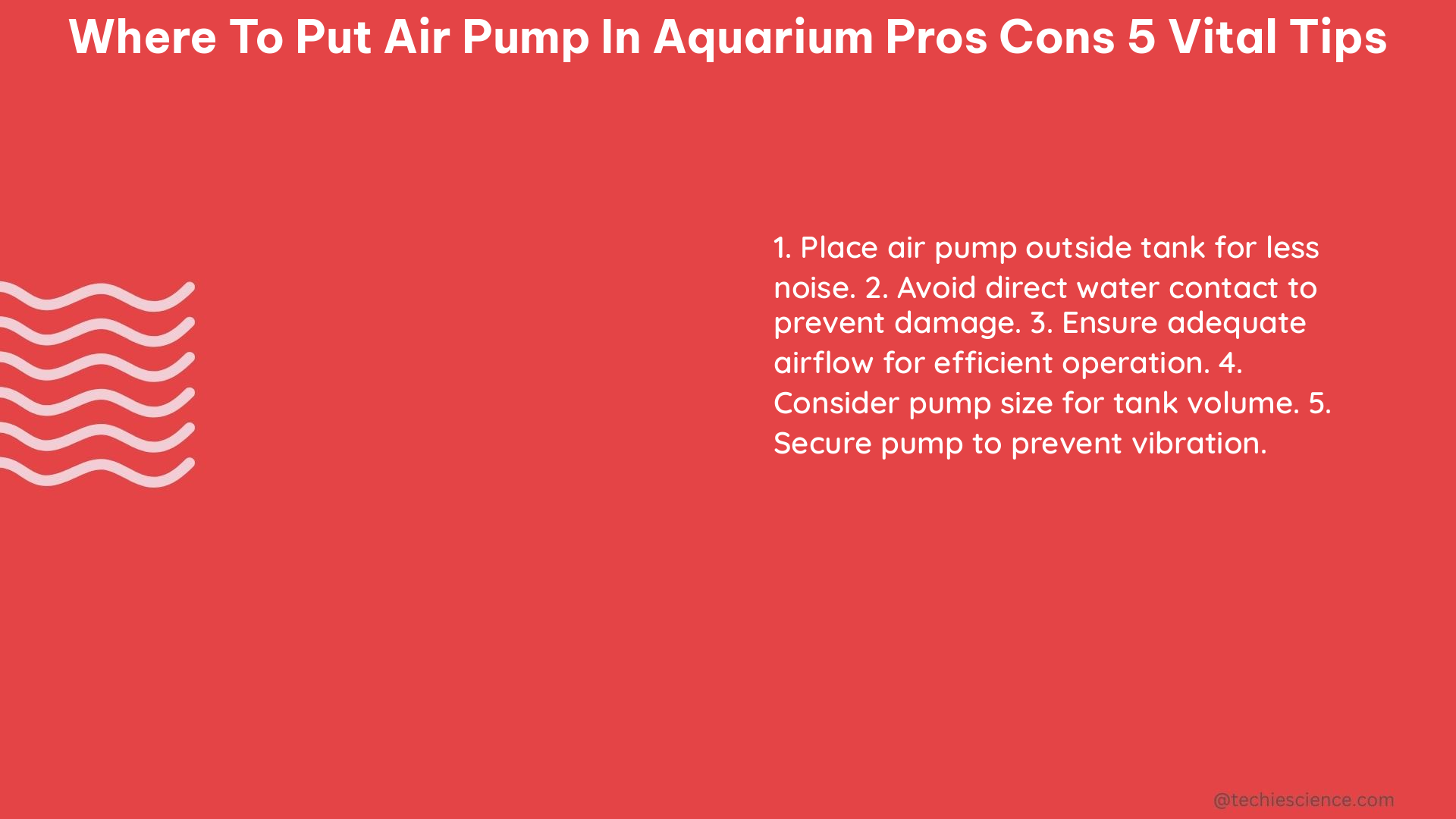When setting up an aquarium, the placement of the air pump is a crucial consideration that can significantly impact the overall performance and efficiency of your aquarium system. In this comprehensive guide, we’ll explore the pros and cons of different air pump placement options, as well as provide five vital tips to help you make an informed decision on where to position your air pump for optimal results.
Pros of Placing the Air Pump Above the Aquarium
1. Prevents Water Siphoning
Positioning the air pump above the aquarium ensures that water cannot siphon back into the pump, which could potentially lead to damage and malfunction. This is a crucial factor, as water siphoning can be a common issue with air pumps placed below the water level.
2. Easy Access for Maintenance
An above-tank placement makes it easier to access the air pump for regular maintenance, such as cleaning, filter changes, or troubleshooting any issues that may arise. This convenience can save time and effort, especially for aquarium enthusiasts who need to perform frequent maintenance tasks.
3. Reduced Noise
Placing the air pump higher up can help reduce the overall noise level in the aquarium setup. The water can act as a natural sound dampener, muffling the noise generated by the air pump and creating a more peaceful environment for both the fish and the aquarium owner.
Cons of Placing the Air Pump Above the Aquarium

1. Aesthetics
Some aquarium hobbyists may find the appearance of the air pump mounted above the tank to be visually unappealing, especially if the pump is a larger model or doesn’t blend well with the overall aquarium decor.
2. Limited Placement Options
Depending on the specific setup and layout of the aquarium, finding a suitable location to mount the air pump above the tank may be challenging. This can be particularly true for aquariums with limited space or unique configurations.
5 Vital Tips for Where to Put an Air Pump in an Aquarium
1. Mount the Air Pump 6-12 Inches Above the Tank
Positioning the air pump at a height of 6-12 inches above the aquarium water level allows for proper air pressure and flow, while also helping to reduce noise levels. This height range provides the optimal balance between performance and noise reduction.
2. Ensure Adequate Ventilation
Place the air pump at least 2-4 inches away from the wall or any other obstructions to allow for proper ventilation and airflow. This helps prevent the air pump from overheating, which can shorten its lifespan and potentially lead to malfunctions.
3. Consider Using a Cabinet
If you prefer to hide the air pump from view, you can install it inside a cabinet or enclosure. To do this, drill a 1/2-inch hole in the cabinet to allow the airline tubing to pass through, ensuring that the air pump still has adequate ventilation and airflow.
4. Choose the Right Size Air Pump
Select an air pump with an appropriate output capacity for your aquarium size and the equipment you plan to use (e.g., sponge filters, air stones). Choosing the correct air pump size is crucial for maintaining proper aeration and oxygen levels in the aquarium.
5. Install a Check Valve
Regardless of the air pump’s location, it’s essential to install a check valve in the airline tubing. This valve prevents water from siphoning back into the air pump, which can cause damage and potentially lead to pump failure, especially in the event of a power outage or pump malfunction.
Technical Specifications for Where to Put an Air Pump in an Aquarium
-
Height: Place the air pump 6-12 inches above the aquarium water level for optimal performance and noise reduction. This height range ensures proper air pressure and flow, while also minimizing the impact of water pressure on the pump.
-
Ventilation: Maintain a distance of at least 2-4 inches from the wall or any other obstructions to allow for adequate ventilation and airflow around the air pump. This helps prevent overheating and extends the pump’s lifespan.
-
Tubing: Use high-quality, flexible airline tubing to connect the air pump to the aquarium equipment, such as air stones or sponge filters. Ensure that the tubing is the appropriate length to allow for easy maintenance and access, without creating any sharp bends or kinks that could restrict airflow.
-
Check Valve: Install a check valve in the airline tubing to prevent water from siphoning back into the air pump. This safeguard is crucial for protecting the pump from damage, especially in the event of a power outage or pump failure.
By following these technical specifications and the five vital tips, you can ensure that your air pump is positioned in the optimal location within your aquarium setup, maximizing its performance, efficiency, and longevity.
References:
– Where to Put Air Pump in Aquarium: Pros, Cons, and 5 Vital Tips
– Air Pump Needs to be Mounted Above the Aquarium
– Aquarium Air Pump: Where to Place It and Why
